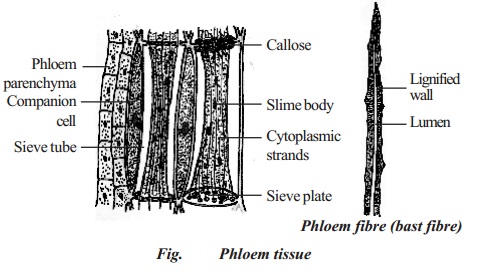Chapter: 11 th 12th std standard Bio Botany plant tree Biology Higher secondary school College Notes
Permanent Complex tissue and Types : Xylem, Phloem

Permanent Complex tissue
A tissue that consists of several kinds of cells but all of them function together as a single unit is called complex tissue. It is of two types x xylem and phloem.
1.Xylem
Xylem (Greek word 'xylos'= wood) is a complex tissue that is mainly responsible for the conduction of water and mineral salts from roots to other parts of the plant. The xylem, which is derived from procambium, is called primary xylem and the xylem, which is derived from vascular cambium, is called secondary xylem. Earlier formed xylem elements are called protoxylem, whereas the later formed xylem elements are called metaxylem. Xylem is made up of four kinds of cells - tracheids, vessels or tracheae, xylem fibres and xylem parenchyma.
Tracheids
Tracheids are elongated with blunt ends. Its lumen is broader than that of fibres. Their secondary wall is lignified. In cross section, the tracheids appear polygonal and thick walled. The pits are simple or bordered. There are different types of cell wall thickening due to deposition of secondary wall substances. They are annular (ring like), spiral (spring like), scalariform (ladder like), reticulate (net like) and pitted (uniformly thick except at pits). Tracheids are imperforate cells with bordered pits on their end walls. They are arranged one above the other. Tracheids are chief water conducting elements in gymnosperms and pteridophytes. Here, the conduction of water and mineral salts takes place through the bordered pits. They also offer mechanical support to the plants.
Vessels or Tracheae

Vessels are perforated at the end walls. Its lumen is wider than that of tracheids. The perforated plates at the end wall separate the vessels. They occur parallel to the long axis of the plant body. Due to dissolution of entire end wall, a single pore is formed at the perforation plate. It is called simple perforation plate eg. Mangifera. If the perforation plate has many pores, then it is called multiple perforation plate. eg. Liriodendron.
The secondary wall thickenings of vessels are annular, spiral, sca-lariform, reticulate, or pitted as in tracheids. Vessels are chief water conducting elements in angiosperms and they are absent in pteridophytes and gymnosperms. However, in Gnetum of gymnosperms, vessels oc-cur. The main function of vessel is conduction of water and minerals. It also offers mechanical strength to the plant.
Xylem fibres
The fibres of sclerenchyma associated with the xylem are known as xylem fibres. They give additional mechanical support to the plant body. They are present both in primary and secondary xylem. Xylem fibres are dead cells and have lignified walls with narrow lumen. Xylem fibres are also called libriform fibres.

Xylem parenchyma
The parenchyma cells associated with the xylem are known as xylem parenchyma. Xylem parenchyma is the only living tissue amongst the consituents of xylem. The cell wall is thin and made up of cellulose. The xylem parenchyma cells store food reserves in the form of starch and fat. They also assist in conduction of water.
2.Phloem
Like xylem, phloem is also a complex tissue. It conducts food materials to various parts of the plant. The phloem elements which are formed from the procambium of apical meristem are called primary phloem. The phloem elements which are produced by the vascular cambium are called secondary phloem. The primary phloem elements that develop first from the procambium are smaller in size called the protophloem, whereas those develop later are larger in size called metaphloem. The protophloem is short lived. It is crushed by the developing metaphloem.
Phloem is composed of four kinds of cells: sieve elements, companion cells,phloem parenchyma and phloem fibres. Companion cells are present only in angiosperms. Companion cells are absent in pteridophytes and gymnosperms. Phloem fibres are absent in the primary phloem of most of the angiosperms. But they are usually present in the secondary phloem.

Sieve elements
Sieve elements are the conducting elements of the phloem. They have thick primary walls. Their end walls are transverse or oblique. The end wall contains a number of pores and it looks like a sieve. So it is called a sieve plate.The sieve elements are arranged one above the other and form vertical sieve tubes. In matured sieve tube, nucleus is absent. It contains
a lining layer of cytoplasm. This is an important feature of sieve elements. A special protein called slime body is seen in it. The conduction of food material takes place through cytoplasmic strands. They are distinguished into sieve cells and sieve tubes.Sieve cells occur in pteridophytes and gymnosperms, while sieve tubes occur in angiosperms.
Sieve cells have sieve areas on their lateral walls only and are not arranged one above the other in linear rows. They are not associated with companion cells. Sieve tubes are arranged one above the other in linear rows and have sieve plates on their end walls. They are associated with the companion cells. In mature sieve elements, sometimes the pores in the sieve plate are blocked by a substance called callose.
Related Topics